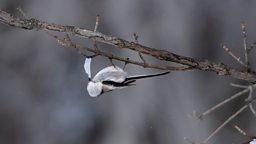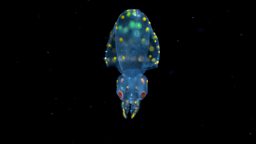In search of kawaii: filming Japan’s cutest bird and the marvel of the ‘sap-cicle’
By Billy Clapham, Assistant Producer

In Japan, ‘cute’ is a big deal. Their own word for it, kawaii (“ka-why-ee”), is more of an ethos than an adjective. Shops and billboards are filled with big-eyed fluffy figures. Every product, business and even government department has some kind of cartoon mascot. Kawaii is to be charming, child-like, innocent, and of course, cute; and on one shoot, we set out to film possibly the most kawaii character of them all: shima enaga – or in English, the long-tailed tit.
In Japan, ‘cute’ is a big deal.
You might be familiar with long-tailed tits if you live in the UK. In winter, flocks of these little chirping birds often visit bird feeders, or flit about amidst tree branches searching for food. In Hokkaido, Japan’s northernmost prefecture, the long-tailed tits lack the black eyebrows of British birds – making them appear even cuter. And only in these frozen realms can you see them engaging in a rather remarkable feeding behaviour.
A long-tailed tit weighs about the same as a one-pound coin. Their fourteen-centimetre length is made up mostly of tail. They are improbable little birds, especially in the context of frozen Hokkaido. As we stood shortly after sunrise next to a defoliated Japanese maple tree, shivering at well below minus 10 degrees Celsius, it seemed utterly mad that such a small bird could survive here. But our aim was to film one of the reasons why they can, an unusual and ephemeral source of sugar at the end of winter: the sap icicle - or ‘sap-cicle’.

To film this phenomenon, we didn’t head to the wilderness; if you want to get close to small birds, you’re better off in an urban park, so that’s where we went. After finding his videos on YouTube, we were outside the flat of ornithologist and budding filmmaker, Rei Shimomura.
But this tree wasn’t just any tree, it was a Japanese maple tree, and those icicles were made from its characteristically sweet sap.
He recalls: “It was a very cold morning, before I went to work, that I first saw some different species of birds visiting a tree at the park. I did not realise what was happening then, but the next morning the same thing happened and then the day after that, too. So I had a closer look at the tree and found several icicles that seemed to have formed on broken and damaged branches.”
But this tree wasn’t just any tree, it was a Japanese maple tree, and those icicles were made from its characteristically sweet sap.
We were now waiting at the same spot Rei first spotted the phenomenon, in the middle of February when we knew the sap should be starting to rise as days lengthened and temperatures crept upwards. But they would only form at just the right temperature, somewhere around minus 2 and minus 4 degrees Celsius. If it was too warm, the sap wouldn’t freeze, and if it was too cold, the sap wouldn’t be runny enough to form an icicle. But even if we had timed our visit right, that didn’t mean the birds would be easy to film.
Rei had warned us: “The most difficult thing about filming them is to be at the right sap-cicle of the right tree at the right time.” We quickly learned that with heavy camera equipment there was no use in trying to follow the flocks of long-tailed tits, we simply had to wait for them to come to us. Yet, as Rei observed, “The tits come and go in a blink of an eye and do not come back again to the same area for several hours.” We soon learned that the best way to keep track of them was to tap into their constant communication.

Long-tailed tits are highly sociable birds, and while they weren’t cooperating with us, they are renowned team players amongst themselves. In spring, birds that fail to breed often help a family member to raise their young. In winter they flock in groups made up of related birds, to find food and huddle together for warmth at night. Their flocking habits mean they are constant communicators. Remarkably, they can recognise a relative from just the sound of their calls, uttering endless high-pitched ‘tsee-tsee-tsee’ notes, or rasping ‘churr’ calls. It’s these vocalisations which gave us a chance of being ready in time when a sudden flurry of long-tailed tits arrived at the maple trees we were staking out.
It was a true excitement at the moment of accomplishment for sure, but also a huge relief.
With Rei tracking a flock on foot and the rest of us spread out listening for their incoming calls, we finally managed to snatch a few shots. Coming and going in an adorable flash, only a slow motion camera could show us what shima enaga was really up to. Some would delicately lick at the sweet ice, while others took little nibbles.
For Rei, “It was a true excitement at the moment of accomplishment for sure, but also a huge relief. That kawaii look is of course the most appealing part of the bird, but I am glad to tell people about their clever strategy to survive the harsh winter of Hokkaido.”

Sap-cicles: a sweet winter treat for long-tailed tits
Maple tree sap forms sugary icicles that offer wildlife a lifesaving, but fleeting, treat.
















